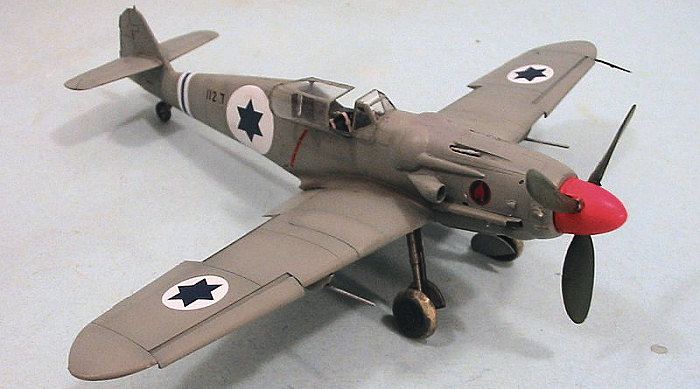
Kiwi Resins/Hasegawa 1/48 Avia S-199
| KIT #: | ? |
| PRICE: | NZ$55.00 plus postage |
| DECALS: | One option |
| REVIEWER: | Tom Cleaver |
| NOTES: | Conversion for Hasegawa 109G-10/K-4 kits |

| HISTORY |
The Egyptian Army thought they would smash Israel in a matter of weeks following the outbreak of war after the May 14,1948 declaration that created the State of Israel. They came close.
In the late afternoon of May 29, 1948, the Egyptian Army’s Second Brigade, equipped with 10 tanks and nearly 500 other armored vehicles, was less than 30 kilometers from Tel Aviv. They were held back by a blown bridge outside the village of Ashdod, and faced only the lightly armed survivors of the Givati Brigade of the Haganah. It was only a matter of hours before the pontoon bridge the Egyptians were assembling would be operational. When the tanks came across, the Givati Brigade would have no choice but to retreat, leaving the road to Tel Aviv open. There was no Israeli force left that could stop the advance.
The Egyptian soldiers didn’t even look up at the sound of aircraft engines in the near distance, knowing they could only be Egyptian, probably sent to attack the Israelis and cover the river crossing.
One fighter approached from the north, flying low toward the Egyptian units inside Ashdod. Suddenly, the wings flashed fire and 20mm cannon-shells ripped through the assembled troops! As the airplane flashed overhead, it dropped two 70-kilogram bombs in the midst of the Egyptians. Those who could look up were amazed to see the blue Star of David on the wings of the fighter as it turned for a second attack.
 In the cockpit, American
volunteer Lou Lenart lowered the nose and opened fire as he turned and
approached from the southeast. Opposition in the form of intense 40mm
anti-aircraft fire finally came up as he wheeled around for a third pass. After
firing 10 rounds on this pass, the 20mm cannons slung under the wings jammed.
In the cockpit, American
volunteer Lou Lenart lowered the nose and opened fire as he turned and
approached from the southeast. Opposition in the form of intense 40mm
anti-aircraft fire finally came up as he wheeled around for a third pass. After
firing 10 rounds on this pass, the 20mm cannons slung under the wings jammed.
As Lenart flew away, Israeli pilot Modi Alon came in from the northeast and attacked the vehicles just south of the bridge. Flying through intense flak, Alon made two more strafing passes before running out of ammunition.
As Alon made his third pass, Ezer Weizman attacked from the south, dropping one bomb on vehicles south of Ashdod. On his second pass he hit the units close to the bridge. While his cannons fired only one shot each before jamming, Weizman strafed with the two 13mm machine guns his airplane was equipped with.
The fourth airplane, flown by American Eddie Cohen, was not so fortunate. Hit badly by 40mm fire on his second strafing pass, the airplane was seen trailing smoke as it flew off to the north.
Lenart covered the 20 kilometers from Ashdod to the secret air base at Ekron in a matter of minutes. He landed just im time to see Modi Alon suffer failure of his left brake as he touched down. Unable to steer a straight path down the runway, Alon ground-looped the fighter, the left tire exploded, and the wingtip struck the ground as he slewed to a stop, severely damaging the airplane.
Minutes later, Weizman landed without incident. Everyone looked for number four, but there was no sign of Cohen. The telephone rang. It was Hatzor air base, reporting that an aircraft engulfed in flames had crashed near the field attempting the land. Two infantry platoons had been sent to rescue the pilot, but the Egyptians had gotten there first. Eddie Cohen was the first casualty of the new Heyl Ha-Avir.
 When the ground crews
checked the three remaining airplanes, they found only half the fuel tanks had
been filled before the mission.
When the ground crews
checked the three remaining airplanes, they found only half the fuel tanks had
been filled before the mission.
The Messerschmitt Bf-109 had just entered its last war, ironically in the service of those the regime it had previously served had sought to eradicate. While the airplanes were indeed Bf-109s, they were a strange variant.
While very few German aircraft of the Second World War remained in use with any air force following the end of the war, only the Bf-109 continued in production. The Bf-109G-14 had been produced in Czechoslovakia by Avia, commencing in 1944, but only a few had been accepted by the Luftwaffe prior to the end of the war. The Avia plant was still intact, which allowed continued production, and two Bf-109G-12s and 20 Bf-109G-14s still on the production line were completed and issued to the National Air Guard that summer, with the single-seater designated the S-99 and the two seater the CS-99. It was planned that more Bf-109s would be produced, but this program received a major setback in September 1945 when a sugar refinery at Krasno Bresno where the entire stock of DB605AM engines for the Bf-109 was stored was set afire, destroying all the engines.
The only other 12-cylinder inverted-vee engine available in the country in substantial numbers was the 1,350 h.p. Junkers Jumo 211F which was intended for the He-111H. The engine was really in no way suitable as a powerplant for a fighter, but it was what was available. The Czechs set out to make do. The G-14 airframe was modified to take the Jumo with a big 3-bladed paddle prop, and was designated S-199.
The conversion was entirely retrograde as regards performance. The Bf-109 was legendarily difficult to take off or land in, and the torque from the huge paddle prop only made things worse since it caused the airplane to swerve as soon as the tail wheel lifted off, requiring the constant application of rudder during takeoff and climb-out. Acceleration was sluggish, the controls were over-sensitive in flight, and landing was even more difficult than taking off. Top speed was reduced from the 435 m.p.h. of the Bf-109G-14 to a claimed 367 m.p.h., though production models barely made 340 m.p.h. Production commenced in 1947. The performance of the airplane was so dangerous that pilots named it the Mezec, Czech for “mule.”
The S-199 entered the history books as more than an afterthought because of the need of the Israelis for any fighter they could lay hands on. Following the UN declaration in the fall of 1947 setting the establishment of the Jewish State for the following May, an arms race developed between the fledgling state and their Arab opponents, who were determined to strangle the baby in its crib. An international arms embargo was declared, but it only affected the Jews. Egypt, Jordan, and Syria already had established armed forces that vastly outnumbered anything the Jews could create with their underground army, the Haganah.
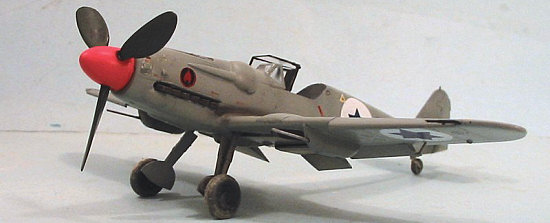 In late 1947, Haganah
agent Otto Felix, who was searching for arms in central Europe, reported the
existence of the S-199, and that the Czechs - who were in need of hard currency
- might be willing to overlook the embargo and sell some of the airplanes. The
Haganah was optimistic that they could buy surplus American fighters that were
sitting on airfields throughout Europe at them time and declined the offer.
In late 1947, Haganah
agent Otto Felix, who was searching for arms in central Europe, reported the
existence of the S-199, and that the Czechs - who were in need of hard currency
- might be willing to overlook the embargo and sell some of the airplanes. The
Haganah was optimistic that they could buy surplus American fighters that were
sitting on airfields throughout Europe at them time and declined the offer.
At the same time, Haganah agent Boris Senior, who had returned to his native South Africa to try and obtain arms, found 50 P-40 fighters that had been previously sold for $1,200 and were about to be scrapped. Unfortunately, the South African government refused export permits for such obvious military items and the logistics of smuggling them out of the country proved too great. In the United States, Al Schwimmer only avoided arrest by the FBI by flying out of Miami with three recently-scrapped B-17s, leaving behind 12 P-47s in Mexico he had been negotiating to buy.
By the end of February, 1948, as the international arms embargo cracked down, the Haganah reconsidered the Czech offer. The next month, the Communists staged their coup in the country, and the democratic government of Czechoslovakia was no more. Would the Communists still be willing to consider the deal? As it turned out, they would. Josef Stalin saw the foundation of the State of Israel as an event that would potentially turn all the Arab governments throughout the Middle East against the West if the State of Israel managed to survive, thus presenting an opportunity to the Soviet Union to gain influence in the region, a traditional Russian goal since the days of the czars. Selling the Jews a few third-rate airplanes at inflated prices was an excellent investment in the future.
On April 23, 1948, Felix signed an agreement to purchase ten Avia S-199s for the ridiculous sum of $120,299 each, including weapons and ammunition, in cash, American dollars only. An additional $80,000 included the services of Czech ferry pilots. The total of $1.8 million equals $13 million in contemporary dollars. At the time, a war-surplus P-51D sold for $4,000 in Europe. Beggars can’t be choosers - Felix took an option on 15 more at the same price.
Within weeks, the arrests in Rhodes of Israeli pilots ferrying Avro Ansons to Israel ended the plan to ferry the airplanes, which had called for stops in Italy and Greece. Transport by sea would be impossible since the airplanes could be stopped in any European port. Machal, an organization of American volunteer pilots that included both Jews and Gentiles, had been established with several Curtiss C-46 Commandos, to smuggle arms into the future Jewish state. Operation Balak was set up to transport the S-199s one at a time from Czechoslovakia to Ekron in Palestine, via Ajaccio, Corsica.
On May 6, 1948, Machal volunteers Lou Lenart and Milton Rubenfeld, accompanied by Israeli Sherut Avir (forerunner of the Heyl Ha-Avir) pilots Modi Alon, Ezer Weizman, Jacob Ben-Chaim, Pinchas Ben-Porat, Itzhak Hennenson, Misha Kenner, Nachman Me'iri, and recent American immigrant Eddie Cohen, flew out of Sde Dov in a chartered DC-3, headed for Geneva via Cyprus and Rome, In Geneva, they took a train to Zurich, then flew on in a Czechoslovakian Airlines DC-3 to Prague. On May 9, they began flight training.
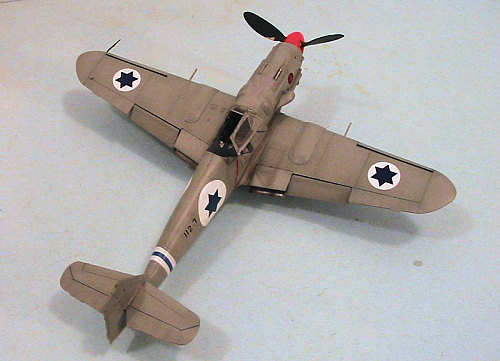 Five days later - the day
of the Declaration of the State of Israel - the first ten S-199s were ready to
be dismantled for shipping. Four days after that, the ten pilots learned that
two Egyptian C-47s had bombed the central bus terminal in Tel Aviv, killing 42
people. The Czech instructors tried unsuccessfully to convince them to stay a
few more days, since they had yet to be trained in air-to-air or air-to-ground
gunnery. They replied they’d learn gunnery on real targets. The five former
combat veterans - Lenart, Rubenfeld, Alon, Weizman and Cohen - moved on to Zatec
airfield, headquarters of Operation Barak.
Five days later - the day
of the Declaration of the State of Israel - the first ten S-199s were ready to
be dismantled for shipping. Four days after that, the ten pilots learned that
two Egyptian C-47s had bombed the central bus terminal in Tel Aviv, killing 42
people. The Czech instructors tried unsuccessfully to convince them to stay a
few more days, since they had yet to be trained in air-to-air or air-to-ground
gunnery. They replied they’d learn gunnery on real targets. The five former
combat veterans - Lenart, Rubenfeld, Alon, Weizman and Cohen - moved on to Zatec
airfield, headquarters of Operation Barak.
On May 20, the five pilots and a small group of Czech mechanics squeezed into a C-54 along with a disassembled S-199, ammunition, and bombs. Nearly 12 hours later, they landed at Ekron. The next night, another S-199 arrived in a C-46. The following night, a third S-199 arrived in the C-54.
On May 23, the first loss was suffered when two C-46s - one carrying bombs and the other the fourth S-199 - flew in from Zatec. Thick fog covered Ekron and fires were lit to guide the two to landing. The first made it uneventfully, but the second - flown by American Norman Moonitz - failed in its attempt and headed for Sde Dov. Gunners there opened fire through the fog at the unexpected arrival. Hit in an engine and attempting to fly back to Ekron, the C-46 crashed south of Latrun. The fuselage of the S-199 broke free on impact and rammed into the cockpit, killing Polish-born American navigator Moshe Rosenbaum, and hospitalizing Moonitz for two weeks. The flights continued each night.
The crews at Ekron hid the S-199s under camouflage nets while the Czech mechanics worked to assemble them. The General Staff wanted them in combat as soon as possible. On May 28, Heyl Ha' Avir commander Aharon Remez informed Prime Minister David Ben-Gurion that it would be at least two more days before the airplanes would be ready, since they had to be test flown. Ben-Gurion replied that there was no time.
The original plan for the first use of the new fighters had been a surprise attack on the Egyptian Air Force base at El Arish in the Sinai peninsula. However, on the morning of May 29, the Givati Brigade blew the bridge at Ashdod in the face of the main Egyptian armored advance, and appealed for air support. The first flights of the S-199s in Israel would be the real thing.
At 1700, the four S-199s that were ready flew into history. Their attack stopped the Egyptians in their tracks, allowing the Israeli forces to hold until the first cease-fire was signed in mid-July. Without that attack, it is entirely likely that the Egyptians would have taken Tel Aviv within days.
The rest of the S-199s were flown into Israel by the end of June. The
unreliability of the S-199 became painfully obvious when the war entered its
second round on July 9. Ordered to attack Egyptian airfields and positions the
evening of July 8, four of the S-199s were assigned to attack El Arish air base,
but were only ready the next morning. One was nearly destroyed in a take-off
accident and another was lost to AAA over the target. The next day, another
S-199 was lost. On July 11, Syd Cohen discovered the fatal flaw of the S-199
when he decided to test-fire his guns. When he did, the cowl guns were out of
synchronization and he 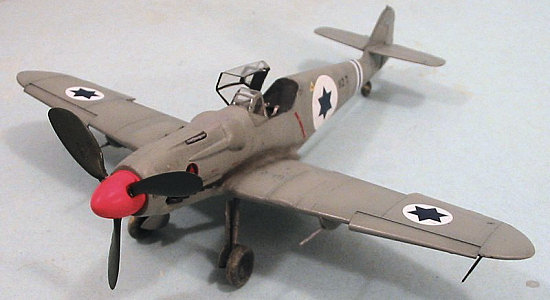 nearly
shot his prop off, but was able to make it back safely to Herzliya. After that,
pilots either test-fired the cowl guns near the field or only used the wing
cannon.
nearly
shot his prop off, but was able to make it back safely to Herzliya. After that,
pilots either test-fired the cowl guns near the field or only used the wing
cannon.
By the beginning of Operation Yoav on October 15 - the offensive that eventually ended the War of Independence - only seven of the 23 S-199s that had made it to Israel were still operational.
On October 16, the Egyptian Second Brigade retreated from Ashdod, where they had remained since the first mission of May 29. Among the officers of the unit were a young Major named Gamal Abdel Nasser, and his close friend and fellow nationalist, Captain Anwar Sadat. That afternoon, Modi Alon and Ezer Weizman attacked the retreating Egyptians. After the attack they returned to Herzliya separately. Alon arrived first. His gear wouldn't come down. In the control tower, Syd Antin spotted an unidentified aircraft at treetop level to the west and radioed Alon, who interrupted his attempt to make the gear come down in order to check it out. After identifying the bogey as a friendly, he resumed trying to lower the gear, and managed to get one wheel down when Antin saw smoke coming from the plane and asked Alon to check the engine temperature. Alon replied all was well as his second wheel came down and he turned final. The plane was too slow and descending too fast. The pilots of 101 Squadron watched as their most charismatic leader crashed short of the runway and exploded. Antin always believed that Alon pushed too hard chasing the bogey and overheated his engine which brought glycol fumes in the cockpit, and that Alon passed out as indicated by his unresponsiveness and the way the S-199 crashed with no attempt by the pilot to avoid it.
By mid-December, 101 Squadron had only six S-199s left and lost one on a take-off accident on December 15. After the first mission on May 29, no more than three S-199s were ever able to get into the air at one time. Considering its problems, the S-199 performed far beyond any reasonable expectation. The airplane literally saved the State of Israel. It may have been a mule, but it was a stubborn one that gave loyal service.
| THE KIT |
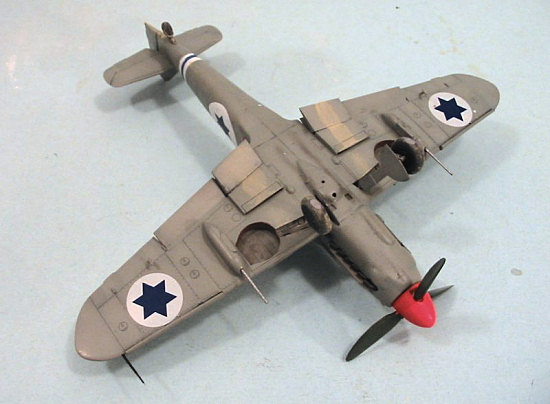 Hobbycraft released a 1/48
S-199 in the mid-1990s, with one kit as an Israeli airplane and a second as a
Czech Air Force airplane, with the later sliding canopy. The kits are still
acceptable, but they share a number of inaccuracies with the other Hobbycraft
109 kits - such as misaligned horizontal stabilizers and different-length
fuselage halves. These kits have only been intermittently available, and have
been out of production for several years, though they were released briefly by
Academy when they stole the Hobbycraft line of kits.
Hobbycraft released a 1/48
S-199 in the mid-1990s, with one kit as an Israeli airplane and a second as a
Czech Air Force airplane, with the later sliding canopy. The kits are still
acceptable, but they share a number of inaccuracies with the other Hobbycraft
109 kits - such as misaligned horizontal stabilizers and different-length
fuselage halves. These kits have only been intermittently available, and have
been out of production for several years, though they were released briefly by
Academy when they stole the Hobbycraft line of kits.
Dave Lochead, owner of Kiwi Resin Models, recently produced a resin conversion kit to make an S-199, that mated the resin fuselage, prop, and accurate cockpit interior with the wings, horizontal stabilizer, landing gear and detail parts of either the Hasegawa 1/48 Bf-109G-10 or Bf-109K, thus allowing a modeler to create a far more accurate model of this last Bf-109 to see combat.
In addition to a new fuselage, prop, and cockpit, the kit also includes a set of decals which are too large to use (though some of them will be very good for using on a coming 1/32 S-199 conversion). I ended up using decals from the dungeon and the remains of the old Hobbycraft sheet for the airplane I didn’t do ten years ago.
| CONSTRUCTION |
The Kiwi conversion kit is a “garage kit,” and as such there are problems to be
dealt with. The fuselage halves are solid in front of and behind the cockpit
area, and this has to either be ground out with a motor tool or sanded flat to
give a good mating area
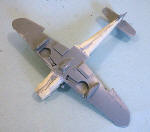 when
assembling the fuselage. With my Dremel on the fritz, I opted for sanding down
the fuselage halves, using a medium-grade sandpaper on a large pane of glass.
You have to be very careful when doing this that you only sand down the areas
inside the fuselage halves, just to the edge of the exterior. Even doing that,
my kit required a lot of Mr. Surfacer along the centerline to get things
smoothed out.
when
assembling the fuselage. With my Dremel on the fritz, I opted for sanding down
the fuselage halves, using a medium-grade sandpaper on a large pane of glass.
You have to be very careful when doing this that you only sand down the areas
inside the fuselage halves, just to the edge of the exterior. Even doing that,
my kit required a lot of Mr. Surfacer along the centerline to get things
smoothed out.
Once that was complete, I turned to painting and assembling the cockpit. This cockpit looks much like the Hasegawa kit, but the S-199 cockpit has detail differences, and these parts provide a more accurate cockpit. I used the Hasegawa instrument panel and instrument panel decal. The cockpit was painted with Xtracrylix “RLM 66 Dark Grey” and finished off by using Eduard pre-painted Luftwaffe seat belts.
After sanding the fuselage smooth and fitting the cockpit, I turned to assembling the wing subassembly from the Hasegawa kit. You have to use either the G-10 or the K-4 kits, since they provide the large wheel well fairings for the upper wing.
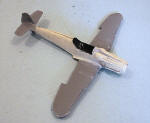 When it came time to attach the resin rudder, I realized it had been “short
shot.” Rather than hassle over this, I cut off the vertical fin above the
horizontal stabilizer, and used the rudder and vertical fin from the Hasegawa
kit. The wing subassembly and the horizontal stabilizers fit to the fuselage
without any problem.
When it came time to attach the resin rudder, I realized it had been “short
shot.” Rather than hassle over this, I cut off the vertical fin above the
horizontal stabilizer, and used the rudder and vertical fin from the Hasegawa
kit. The wing subassembly and the horizontal stabilizers fit to the fuselage
without any problem.
It was at this point that I realized there was a big problem with the Falcon vac canopies provided (the kit provides both the side-hinging German canopy and the later sliding bulged Czech canopy). These are designed for the Hobbycraft kit, which does not have the separate quarter-light panels as the Hasegawa kit does. It would be impossible to use the Hasegawa windscreen, since the quarter-light panels bulged out to fit with the different cowling. Fortunately, I have the Falcon “Bf-109 Special” set of Bf-109 canopies, and one of them included a windscreen that would do the job. I dipped the vacuform canopies in Future and proceeded to the paint shop with the model.
| COLORS & MARKINGS |
Painting:
The Israeli S-199s came in an overall paint scheme of RLM 02 Grey-green. After applying “pre-shading” to the panel lines with flat black, I used Xtracrylix “RLM 02,” which I lightened with some Xtracrylix “Light Aircraft Grey” to post-shade and fade the paint. I gave the prop spinner a coat of Xtracrylix “Red Arrows Red” and painted the propeller blades with Xtracrylix “RLM 70 Dark Green.”
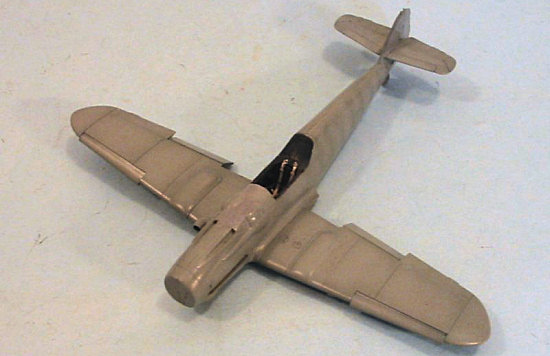 I then masked and painted
the canopies, first applying Xtracrylix “RLM 66 Dark Grey” for the interior
color and then painting the exterior RLM 02.
I then masked and painted
the canopies, first applying Xtracrylix “RLM 66 Dark Grey” for the interior
color and then painting the exterior RLM 02.
Decals:
The Israeli S-199s went through several different stages of markings, beginning with rather small Star of David insignia and then progressively repainting these larger for identification purposes. I was committed to doing “D-112" because of decal availability. This airplane arrived in the beginning of the second batch, just as the insignias started to grow. Available photos show that it was originally given small Star of David insignia. The fuselage insignia was then repainted with a larger white circle, though the star was not enlarged. The upper wing insignia remained small, while the lower wing insignia was enlarged for identification by ground troops. I sourced the wing insignias and the fuselage stripe from the decal dungeon, and used the 101 Squadron insignia, the fuselage insignia and the D-number from the old Hobbycraft S-199 sheet. The red-and-white stripes on the rudder did not appear on S-199s until late September. Since D-112 was lost in August, this aircraft would never have used them. This was fortunate since I didn’t have decals for that marking that would fit.
| FINAL BITS |
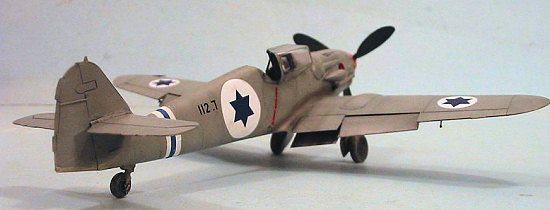 The paint on the S-199s was
semi-gloss when they first arrived. Since D-112 didn’t last all that long, I
gave the model a coat of Xtracrylix Satin Varnish, followed by a light coat of
Xtracrylix Flat Varnish, which was deliberately applied leaving “holidays” of
the final varnish, so that the model has an uneven finish when seen in person,
which is how the semi-gloss finish would appear as it was “sanded down” by the
flying dirt at Herzliya air base where D-112 would have operated. I also
“muddied up” the wheels with the Tamiya “weathering makeup kit” and applied
exhaust stains with Tamiya Smoke. I didn’t further ding the model, as it
appears the original didn’t last long enough in service to have been badly
weathered and “dinged.”
The paint on the S-199s was
semi-gloss when they first arrived. Since D-112 didn’t last all that long, I
gave the model a coat of Xtracrylix Satin Varnish, followed by a light coat of
Xtracrylix Flat Varnish, which was deliberately applied leaving “holidays” of
the final varnish, so that the model has an uneven finish when seen in person,
which is how the semi-gloss finish would appear as it was “sanded down” by the
flying dirt at Herzliya air base where D-112 would have operated. I also
“muddied up” the wheels with the Tamiya “weathering makeup kit” and applied
exhaust stains with Tamiya Smoke. I didn’t further ding the model, as it
appears the original didn’t last long enough in service to have been badly
weathered and “dinged.”
I then attached the prop, landing gear, gun sight and canopies.
| CONCLUSIONS |
This is an excellent resin conversion kit, that results in an accurate model of an historically-significant airplane, and provides a better final result than the old Hobbycraft kit. Those “109 nuts” who want at least one of every sub-type of the Augsburg Eagle in their collection would be well-advised to get this kit if you haven’t already, since it is no longer in production and supplies are limited.
February 2007
Copyright ModelingMadness.com. All rights reserved. No reproduction in any form without express permission from the editor.
Note that as of this date (2017), the conversion set is no longer available.
If you would like your product reviewed fairly and fairly quickly, please contact the editor or see other details in the Note to Contributors.